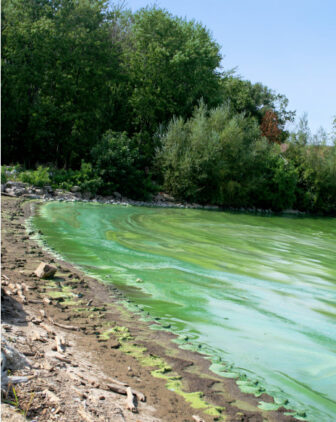
Lake Erie during an algal bloom: Environmental Protection Agency.
By Jake Christie
Algal blooms are wreaking havoc in Lake Erie, but the Michigan Department of Natural Resources (DNR) has a plan: Wetlands.
Those blooms commonly occur when run-off from farmland carrying fertilizer enters a body of water, like Lake Erie, creating a nutrient dense environment for algae to thrive.
“What we have for Lake Erie is a lot of phosphorus,” said Tammy Newcomb, the senior executive assistant director of the DNR.
“Phosphorus would normally bind to soil before it would runoff, but it requires a certain amount of time to sit in a location for that natural process to occur,” she said.
A wetland that can intercept runoff from farms would act as a barrier, slowing down the flow of the water and giving the phosphorus time to absorb into the soil.
Runoff high in phosphorus has been worsened by increases in pavement and technology that helps farmland to drain, Newcomb said
The DNR is working with the state departments of Environment, Great Lakes and Energy and Agriculture and Rural Development as well as the nonprofit Ducks Unlimited to develop and maintain a wetland in southeastern Michigan.
The DNR is looking in the Upper Maumee River and River Raisin watersheds, which could place the project in Monroe County or Lenawee County.

Map of the Upper Maumee River and River Raisin Watershed from the Department of Environment, Great Lakes and Energy website.
While Newcomb said the DNR wants to move the project along quickly and has found suitable sites in those areas, it hasn’t found a site on land owned by a willing seller.
This type of project usually restores former wetlands, as the existing seedbed makes developing wetlands easier, said Chris Sebastian, the sustainability lead and external affairs manager of the Great Lakes/Atlantic Region of Ducks Unlimited.
Ducks Unlimited would be shouldering the engineering part of the process while contracting out the actual construction of the wetland, Newcomb said.
Sebastian said construction of a managed wetland – a wetland with a controlled water level – consists of installing a series of drains and pipes to control the water level while raising land around the area to prevent flooding the adjacent land, Sebastian said.
That infrastructure would also allow the DNR to funnel runoff directly into the wetland where it would filter out the excess phosphorus, Sebastian said.
The purchased land would become a state recreational area, facilitating hunting, bird watching and hiking in a section of the state with few outdoor recreational opportunities, according to Newcomb.

Image: Asher Freedman
Under the new plan, the project would cost around $2.8 million to buy the land and to pay for its development and maintenance.
Similar projects take about two to three years to complete once a suitable area has been purchased, and projects can range from a few acres to a few hundred, Sebastian said.
The money for the project would come from the Michigan Natural Resources Trust Fund and the Great Lakes Restoration Initiative.
By shutting down fisheries and hampering tourism, algal blooms are estimated to cost the United States $82 million a year, according to the National Oceanic and Atmospheric Administration.
Such blooms have a variety of adverse effects on their ecosystems.
Some blooms are nothing more than an annoyance, while others release toxins or cause dead zones, areas in bodies of water that cannot support life, according to the Centers for Disease Control and Prevention.
The project is an extension of the Michigan Domestic Action Plan for Lake Erie, which set the goal of a 40% phosphorus reduction in Lake Erie by 2025.
Currently the Department of Environment, Great Lakes and Energy is also educating farmers on conservation practices and working to reduce phosphorus loads at four wastewater treatment plants.